- APPROACHING PIAZZOLLA’S MUSIC: an analysis of his music and composition styles (2)
- Milonga del ángel
- Fuga y misterio
- Summary
- Libertango (Piano solo) – Astor Piazzolla con partitura (sheet music)
Browse in the Library:
APPROACHING PIAZZOLLA’S MUSIC: an analysis of his music and composition styles (2/2)
Browse in the Library:
Milonga del ángel
As for Soledad, Milonga del ángel has the milonga rhythm as a basis more or less throughout the entire piece. Except for the middle section, the primary melody is repeatedly presented.
Consequently, the element that is processed is not the melody; instead, it is of more interest to study the contexts of which the melody is placed.

The articulations between the sections are characterised by a continuous flow, and there is no dominant chord that prepare for their arrival; however, the sections are still smoothly merged.
The first primary section (P) establishes the harmonic environment and presents the primary melody twice. Furthermore, the secondary section (S) starts with modulating sequences and then continues with a part that is reminiscent of P. The last section is more or less a recurrence of the first section, although with a more refined environment. As with Soledad, it
is possible to read the large scale structure as an ABA structure. In fact, these two milongas are rather similar in large and middle scales respectively.

In the introduction (O), the motivic chord gesture that opens every subsection, except for T and 2T, is presented. Letting this gesture end the O subsection smoothly merges the O and P subsections; thus, the subsections overlap each other.
The changes of key areas between subsections enter without fifth motions in the bass line. Instead, the changes are characterized by ascending chromatic motion. Either it is only the melody that is moving, or it is both the melody and the bass line. The bass line’s gesture is probably derived from the arrastre gesture and therefore I define this kind of key change for as ‘change of key area by arrastre’.
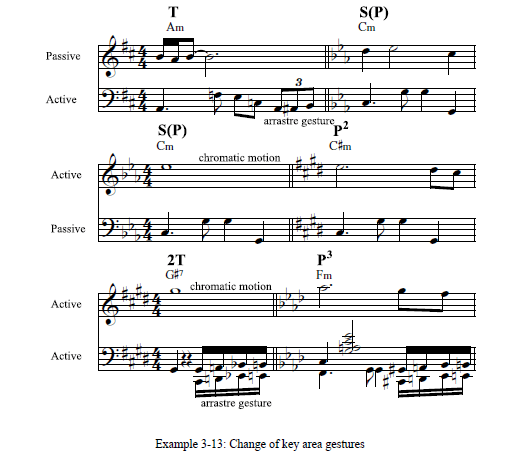
With a single bar gesture as basis, the primary melody is present almost the entire piece through. While preparing for the melody’s arrival by establishing an atmosphere, the introduction also presents a motivic gesture that is frequently recurrent throughout the piece.

In P and P2, the same process continues, though in different keys, and in P1 and P3 it is slightly accustomed. Remains of the primary melody is also to be found in the S(P) subsection. Just like in Soledad, there is a large amount of ‘jazzy’ II-V-I chord progressions in minor mode; altered fifths and ninths are used frequently. Except for T and 2T, the bass line is pending, moving in fifths or moving in descending motion. In the following illustration, notice how the usage of reinterpretation of the chord in bar four (C#7b9/B to E13b9no1/B) enables an immediate transfer to Am.
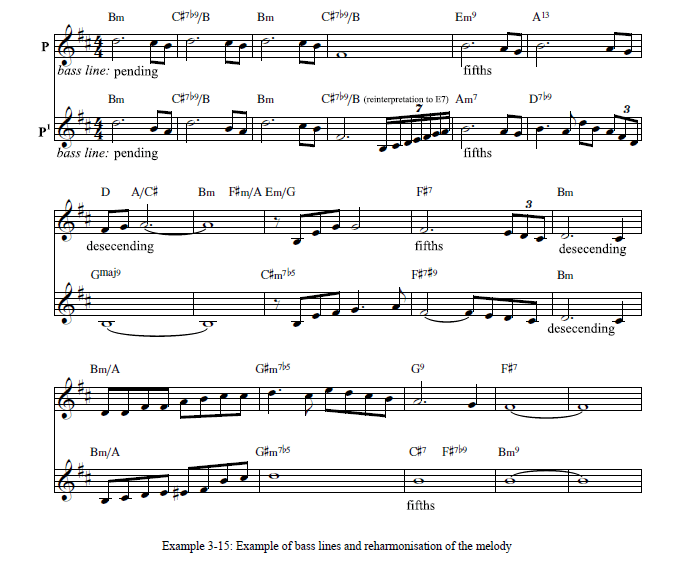
Just as in Libertango, the melody is moving in triads when the bass line is pending; it seems like the melody is active when the bass line is passive, and the melody is passive when the bass line is active. As the illustration shows, the melody is a descending motion from the second to the fifth note in the scale. Linked together with an arppegio, the structural motive
(D B A G F#) is presented at the beginning and at the end.

Unlike the other subsections, T is a more rhythmical passage where two tresillo rhythms and the mordent rhythm confront each other in sequences. P1 and S(P) may be smoothly merged without T though, especially since they end with the same note. Perhaps it is not satisfying defining this passage as a transition; hence, it might rather be defined as an excursion or as sequenced tonicizations (to make it more graphically, I have excluded the chords in the illustration).
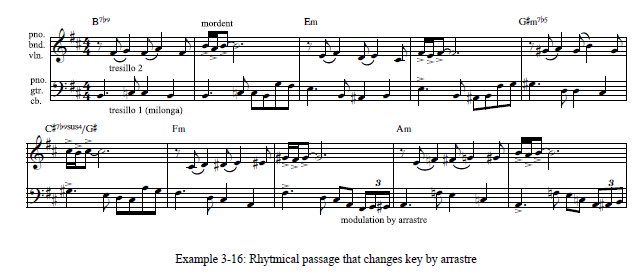
The similiarities between Soledad and Milonga del ángel are quite recognisable: e.g. the ‘jazzy’ chords; frequent mordents; accompaniment gestures; lyrical melody; and naturally the milonga rhythm that saturates them. A major disparity though, is the way the change of key areas are realised; in Soledad by descending chromatic motion with pedal, and in Milonga del ángel by ascending chromatic motion. In the latter case though, the gesture is implemented just before the new key arrives; in the former case, there is a preparation that lasts for several bars and it is not that clear where the new key enters.
Just as Soledad, Milonga del ángel has an ABA-structure and with the milonga rhythm as basis it is characterised by long note values, ‘jazzy’ chord progressions and change of key area by arrastre. Throughout the piece, the primary melody is located in different environments regarding harmony, tempo and instrumentation.
Fuga y misterio
In the same manner as for Fugata, I prefer to analyse Fuga y misterio as three sections: fugue exposition; middle section with melody and accompaniment; and a closing coda-section, which differs from the first two sections.
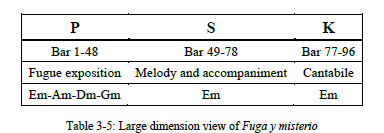
Covering half the piece, the first section (P) is a fugue exposition in four parts, which through a large-scale fifth motion changes key from E-minor to G-minor.
The secondary section (S) presents a contrasting theme that is accompanied by a chord progression that is derived from the fugue theme. Leading back to the primary theme, this section reveals the chord progression that has been hinted in the exposition. The last section (K) is a slow cantabile passage where a new melody theme is presented. While the fugue exposition (P) has a polyphonic texture, the other sections have a texture of ‘melody and accompaniment’. Though every section is in minor, the two first sections are a little ‘edgier’ due to the augmented fourth (or the jazz blue note) that is exposed already from the beginning. The large-scale structure can be read as an ABC-structure.

In the fugue exposition, which is characterized by a rhythmical contrapuntal texture, there are strong accented rhythms. Short note values are predominating. Just as in Fugata, the most frequent surface rhythm of the fugue theme is tresillo 1. The key change between these subsections is realized by transforming the tonic chord into a dominant (e.g Em E7 Am).
Thus, unlike the exposition in Fugata, there is no preparation of the new dominant. In the following illustration, notice how the last bar of the fugue theme is a diminished variation of the two first bars.
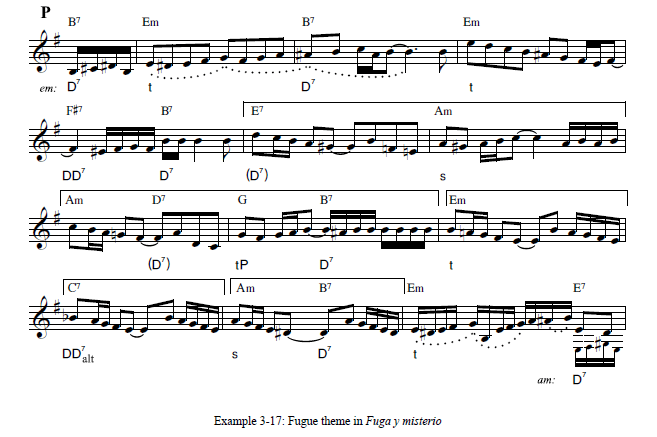
Reaching G-minor, the exposition is accomplished and the key of the secondary subsections (Em) is introduced without preparation; the only gesture that indicates E-minor is an ascending diatonic bass line (B C# D#). With the marcato base as a basis, the secondary subsection presents a contrasting melody that is characterized by mordents and harmonic
intervals such as the diminished 10th and the added 11th, which serves as top notes in chords.
The last secondary subsection is a recurrence of the fugue theme, presented in a homophonic environment though. As pointed out earlier, the last subsection (K) is a cantabile passage that differs quite a lot from the other passages. It is slower, have longer note values, and it is the
first time in the piece that there is a descending bass line in crotchets present.
The fugue exposition is rather similar to the one in Fugata, especially regarding the treatment of gestures, counterpoint and change of key areas; it is rather clear to see Piazzolla’s influences from the inventions of Bach. Notice also how the usage of instrumental rubato automatically implies that tresillo rhythms are accented.
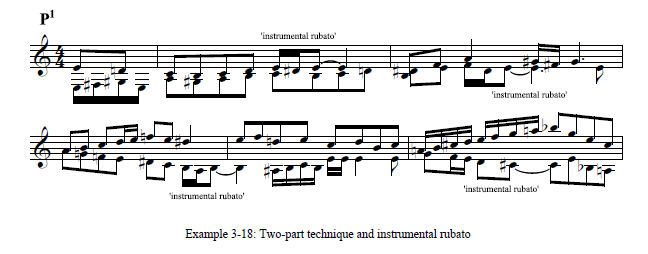
The melody has typically stepwise motion or motion as skips, which reaches chord notes.
Similar to Fugata, this applies to all fugue parts. The most common intervals in parallel motion are thirds and sixths. In contrast to Fugata’s chord progression, which is based on a descending bass line, the chord progression in Fuga y misterio is instead based on II-V-I progressions. With a cycle of fifth as a basis, the II-V-I sequences implies tonicization; Bm-E7-Am Am-D7-G instead of E7-Am-D7-G.72 The first subsection of S is a more homophonic passage where the secondary melody is harmonized with block technique.
As pointed out earlier, the chord progressions are rather similar to the progressions in the exposition’s first eight bars, though with altered chords similar to the ‘jazzy’ one’s used in Soledad and Milonga del ángel. In the first four bars, which are rather static due to its harmony based on primary chords, the low notes in the bass line is reached through octave leaps. This implies an accentuation that enhances the static state. As in e.g. Fuga, there are also several percussive gestures produced by dissonant chords.
Due to its different style regarding tempo, harmony and melody, the last subsection has a completely different character. The most significant characteristics are the descending bass line and the 9-8 appoggiaturas that are exposed in the melody. Implemented as sequences, the chord progression is rather similar to the one that is to be found in the primary subsection of Soledad.
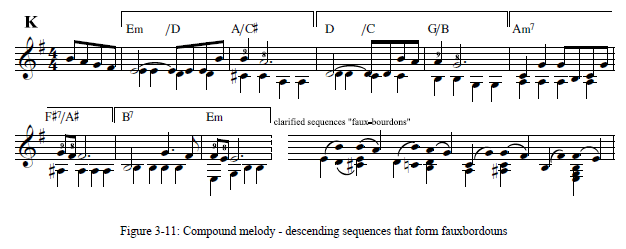
The very last bars are a descending chromatic gesture presented by diminished seventh chords, though with the tonic pedal as bass note. Ending with a B7b9 (without root note though), these last four bars functions as codetta. The gesture may be regarded as a T-DD-s progression, which is similar to the motivic chord gesture in Libertango.

Fuga y misterio has a structure similar to the one found in Fugata: A fugue exposition as a start; melody and accompaniment in the middle; and a closing section that is rather different than the other two. There is no key change between sections (but the key changes within sections though), and the harmony is characterized by chord progressions with primary chords
and fifth motions by tonicization sequences.
Summary
This chapter will give emphasize techniques and musical events that are, in a general perspective, mutual to the compositions that have been analysed. As suggested of LaRue, I have chosen to categorise the characteristics of Piazzolla’s music that I have found into four categories: harmony; melody; rhythm; and structure (I prefer using structure as a category instead of growth). The sketches and the tables are not exact rules of how Piazzolla’s music functions; they are rather to regard as suggestions how to relate to his composition style.
The change of key areas may be categorised into two main categories: maintaining the key or entering a new key. As pointed out in chapter 1.5, LaRue defines this as ornamental modulation and structural modulation respectively. The techniques, which are to be found in both categories above, I define as ‘tonicization’ and ‘descending chromatics with pedal’.
Thus, they are used for both purposes. The following illustration shows my suggestion on how to regard the tonicization technique.
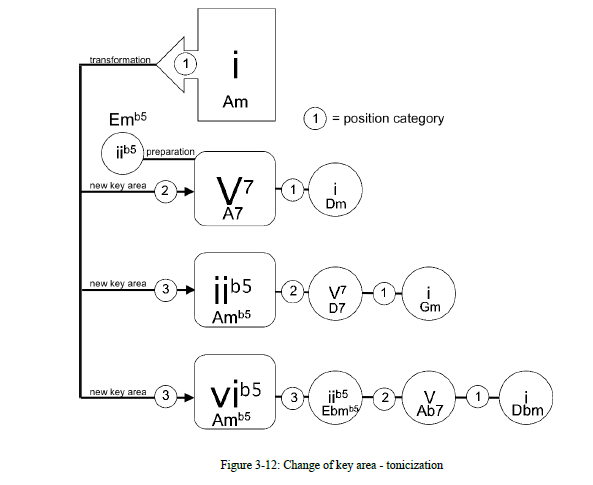
The latter one is concerning the relation between a descending chromatic motion and its pedal accompaniment in the end of subsection. Unlike the tonicization technique, this procedure does not include any intermediate tonic states; there is either no change of key area at all, or the passage has the aim to modulate. It seems like when a new key is going to be established the pedal is fading out before the new dominant chord (this is not the case in the K-section of Fugata though). When the key is maintained the pedal keeps on going, and it seems like it frequently has a role of a dominant. In its simplicity, it may be illustrated as follows:
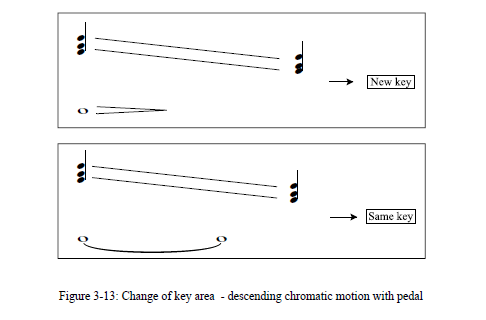
Additionally, Piazzolla also changes key without preparation by implementing the arrastre gesture74 (as described in Milonga del ángel). As pointed out in Soledad, two techniques are sometimes combined.
There are three characteristics regarding melody that I want to point out. The first one I define as ‘ostinato gestures’, which are rhythmical patterns based on tresillo rhythm 4 and 7.
Frequently subordinated the main melody though, they contribute to the melodic tension by exposing characteristic intervals (e.g chord notes like b9, #5 and 13).
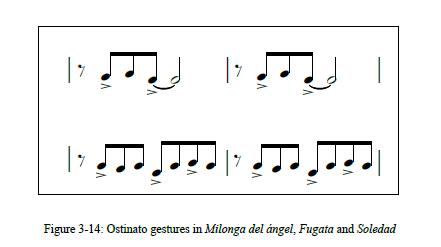
The second one, which describes the relation between the top voice and the bass line, I have chosen to define as ‘uniform ambitus’. It seems like when the bass line is pending, the top voice has a more active role; it moves in arpeggios and repeatedly presents an immanent chord progression. Consequently, when the bass line is more active the melody’s ambitus decreases.
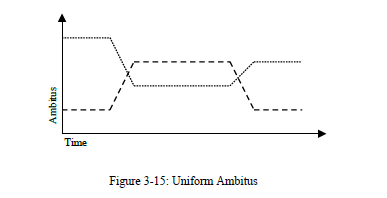
The third characteristic regarding melody is the melodic motion. Applicable in small dimensions, when descending, the melody tends to have a stepwise, often chromatic, motion.
Furthermore, when ascending it tends to move in leaps or in arpeggios; consequently, there are also neighbor notes implicated.
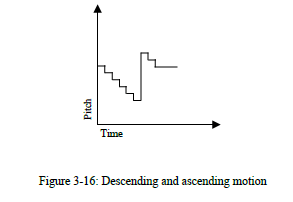
Two common large-scale structures that the analysed pieces share are the ABA-structure and the ABC-structure; ABA in the milongas, and ABC in the fugues.
As pointed out earlier, Piazzolla freely uses the tresillo rhythm and its shifts. In addition to the original rhythm, which is the most common, it seems like the second, the fourth and the seventh shift are the most common rhythms that are based on the tresillo. Particularly clear in
Fugata, the tresillo rhythm is also to be found in large-scale patterns. In this piece, the tresillo rhythm is carefully distributed which makes the ABC-structure mathematically equal to 3:3:2.

Piazzolla’s sheet music available for download from our Library.
Previous Post:
APPROACHING PIAZZOLLA’S MUSIC: an analysis of his music and composition styles (1)
(Next Post: “Composition”)
